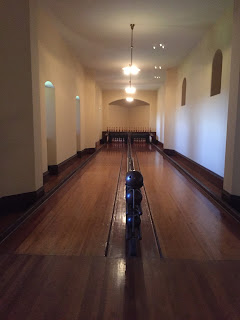The Biltmore Estate was constructed in 1895 by railroad and steamboat tycoon George Washington Vanderbilt II. Plans for the estate began in 1888 after Vanderbilt visited his mother in Asheville, North Carolina. He was quick to take note of the beauty and climate of the area. Vanderbilt bought up 700 parcels of land from local farmers. By all accounts these farmers were more then willing to sell, due to the land being in poor condition. The construction of the mansion began in 1889 and lasted until 1895. The original plan called for a modest Colonial Revival style structure, but things quickly turned in the opposite direction. When all was said and done, the completed product was a Châteauesque-style mansion. The finished square footage was 178,926. During construction a brick kiln was built on site. A total of 32,000 bricks a day were produced. A three mile long railroad track was constructed to help bring in construction materials. Vanderbilt traveled all over the world, purchasing furnishings for his new house. Among the items he purchased were tapestries, paintings, carpets, and linens. On Christmas Eve 1895 Vanderbilt opened Biltmore. He invited family and friends from all over the world. From 1895 to 1898, Vanderbilt lived as a bachelor. In 1898 he married Edith Stuyvesant Dresser. She had never seen George's estate. Upon returning from their Paris wedding and subsequent honeymoon, Edith saw her new home for the first time. One can only imagine what she thought. By the turn of the century, new income taxes were making it harder for the Vanderbilt family to manage the estate. George had to sell off 87,000 acres of his land. In 1900, George and Edith's first and only child was born. Cornelia Stuyvesant Vanderbilt was born in the Louis XV room. Cornelia was most likely named after her great grandfather Cornelius "The Commodore" Vanderbilt. She grew up at Biltmore estate, residing there until 1934. In 1914, tragedy hit Biltmore. George Vanderbilt II died after complications from an emergency appendectomy. This left Edith to run the estate. She sold a portion of the estate to the Federal Government to help create Pisgah National Forest. She saw this as a way to honor her late husband. She later consolidated and sold her interests in Biltmore Industries and Biltmore Village. She continued her philanthropic work by taking maternity baskets to new mothers, and also sponsoring children's literacy programs. In 1925 she met and married Peter Goelet Gerry. The two moved to Rhode Island, leaving Cornelia and her husband John Francis Amherst Cecil to manage the estate. During the Great Depression, the couple decided to open up Biltmore to the public, to help boost tourism in the city of Asheville. During World War II the estate closed, but was used by the Federal Government to house 62 paintings and 17 sculptures from Washington D.C.'s National Gallery of Art. The Cecil family continued to reside in the house until 1956. Ever since, Biltmore has been a museum and one of the United States' largest tourist attractions. It still holds the title of the country's largest home, and sees roughly 1 million visitors per year. The Vanderbilt family still owns the house and its grounds and strives to operate it like a family business. The house has been featured in movies such as Tap Roots, Forrest Gump, and Richie Rich. Three United States Presidents have visited Biltmore, they include William McKinley, Theodore Roosevelt, and Woodrow Wilson. Biltmore was entered in to the National Register of Historic Places in 1963. The hospitable nature of the Vanderbilt family continues to live on through Biltmore Estate.
From the back porch of Biltmore, one can see just why George Vanderbilt fell in love with the area.
These pictures give an idea of just how ornate Biltmore really is. It actually has architectural features that make it more of a castle instead of a house.
One of Biltmore's most famous rooms is the grand banquet hall.
Biltmore also features a bowling alley, swimming pool, and numerous acres of gardens.
Be sure to come back next week for another installment of Moore Historical Consulting's Throwback Thursday series. Whether your need is genealogy, historic litigation, preservation, or anything in between, contact me today and put me to work for you.








No comments:
Post a Comment